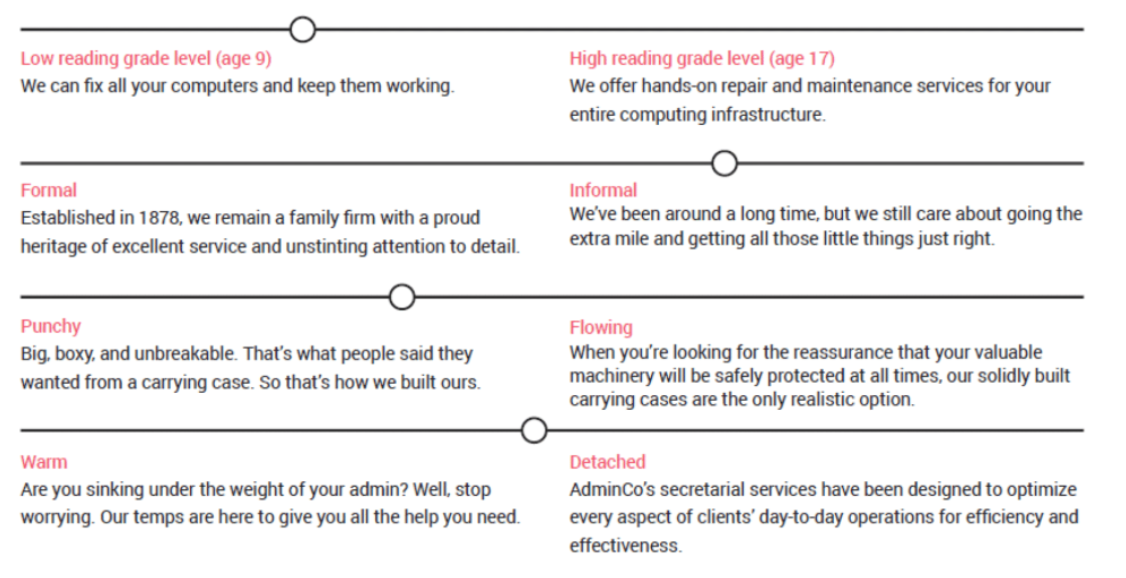
How one succeeds as a business owner or brand owner isn’t just about putting products and services in front of people daily. There are key marketing concepts, which are greatly important and require both copywriting skills, supporting evidence of claims, and staying in front of anyone who might raise an objection. Knowing the right words to put down to 1) attract readers and 2) convince prospects to connect involves research, skill, experience, and, in our opinion, talent too.
We know how overwhelming writing and creating content can be. You’ve searched online for tips to help you craft compelling, persuasive copy; you see different guidelines, rules, tips, and advice, but just trying to comprehend all the materials and put them into writing leaves you speechless about where to start and how to write in a convincing way.
We won’t pretend that creating any type of content that triggers actions is easy. At the same time, there are proven methods from our experience, we are willing to share with you, to make things a little bit easier!
Knowing the proper persuasive copywriting techniques, can make you a copywriting pro and help you close more business.
In the following sections, we will cover:

Marketing copy is a combination of words intended to connect with and engage your prospects via promotional and advertising channels.
It aims to capture the attention of, communicate with, and educate your prospects on the benefits of your products or services. Persuasive content comes in the form of a story told via video, email, articles, or audio recordings. It creates brand awareness and builds relationships with your prospects.
Too often we see content, which focuses overly on features. Covering features of a product or service certainly has a place and time, however, benefits are where your buyers stop and listen. If you are great at explaining the benefits of what you offer, you will without a doubt capture the reader’s attention, and even better, keep them engaged for longer.
Good marketing copy should focus on your customers’ wants, and challenges, and how you can solve those. Make them your priority.
Persuasive writing is a vital tool that every business should possess.
Think about it. Everybody you meet has their own way of expressing themselves, as unique as their face or fingerprint.
The voices we hear range from nasally and shrill to deep and silky smooth.
Some tones are pleasant and polite. Others are pushy and in-your-face.
Some can say it all with just a few words, while others never seem to get to the point.
The way a business communicates—and the way their communication is perceived—is no different. And if they’re consistent about doing it the right way, the connection they establish with their customers can be a very powerful marketing tool.
Is There Really a Difference Between Voice and Tone?
Sure there is. Consider the way we talk. Our voice is always the same, but the tone in which we speak changes depending on who we’re speaking to, and in what context. Our tone will shift when we communicate with our spouse, our boss, our best friend, or our dog.
To put that in terms of your marketing communications, your brand voice is singular and should always remain consistent. Your tone, though, might shift depending on the medium. For example, a corporate letter from the CEO will have a different tone than an attention-grabbing Facebook ad.
Ultimately, your tone isn’t about what you say, but how you say it. It dictates how the personality and character of your brand are portrayed.
Marketing writing (especially B2B) doesn’t always consider voice/tone. As a result, the writing becomes non-discernible with no clear identity. It’s often too serious, formal, heavy on features and jargon, and worst of all—an inconsistent jumble of styles.
Here’s why creating a tone of voice for your brand is critical:
It makes you human. Your customers are people—often warm, friendly, and down-to-earth. When you speak to your audience as peers and friends, you instantly become more relatable and authentic. Corporate buzzwords and jargon come across as insincere.
It makes you different. If you took your logo off your website or sent unbranded emails, would your tone be immediately recognizable, or would you sound just like your competitors? Your unique tone can create a memorable relationship with the reader they won’t find with other brands.
It can substitute in-person communication. With fewer opportunities to talk face-to-face, your written words become even more powerful. The tone of your website and marketing material can lay the foundation for a strong working relationship.
It builds authority. When you write with personality and style, it shows you have confidence in what you’re saying. This resonates with readers, making you trustworthy and valuable.
It gives you focus. As markets get more crowded and competitive, your brand identity is paramount. Creating and using a tone of voice will help you hone in on the true essence of your brand—and why your audience should care.
It helps drive action. At its core, all marketing copy should: establish an emotional connection (we know your pain), ignite desire (escape from pain is within reach), and provide the direct action to fulfill that desire (do this to find relief). This becomes easier with a clearly defined tone of voice.
There are many different types of tones, here are a few examples:

*Source: Chart from “Watch Your Tone! The Ultimate Guide to Developing Your Company’s Tone of Voice.”
Different brands will have different value propositions that appeal to different audiences with different sensibilities. In other words, there is no “one-size-fits-all” tone of voice. It needs to be nuanced, and unique, and rely heavily on your specific brand values.
Anchor your tone of voice in your brand by making it an expression of your way of thinking.
Let’s take a look at an example. Here are brand values translated to the tone of voice for an organization that hosts large annual conferences and trade shows for the food & beverage industry. We’ll call them “F&B Worldwide.”
Brand Value 1: Welcoming
Meaning: We want our readers to feel a special camaraderie. We may come from different places with unique talents and diverse skill sets, but we share a common bond: a deep passion for the F&B industry.
How to translate brand value “welcoming” to your tone of voice:
Brand Value 2: Vibrant
Meaning: We are energetic and lively. Our community and our event are a place of inspiration and invigoration.
How to translate brand value “vibrant” to your tone of voice:
Brand Value 3: Stylish
Meaning: We want to demonstrate the inherent elegance and grandeur that defines our industry and the people within it.
How to translate brand value “stylish” to your tone of voice:
Brand Value 4: Intelligent
Meaning: We are a progressive organization that remains ahead of the trends that define our ever-evolving industry.
How to translate brand value “intelligent” to your tone of voice
Now, here are those brand values brought to life with varying degrees of writing styles and tones.
Zzzz…
Technical, verbose, inwardly focused. A lot of pomp, mimsy, and hollow jargon.
For three decades, F&B Worldwide has provided premium professional development by leveraging resources, educational publications, and award-winning tradeshows for the food & beverage industry—from caterers to culinary professionals to business owners—helping them elevate their career trajectory and revolutionize their businesses.
Better, but still a tad meh.
Factual and to the point, but a little stiff and disconnected.
As the premier show for food & beverage professionals, F&B Worldwide unites a passionate community looking to perfect their art and enhance their services through four impactful days of learning, networking, and fun.
Now we’re talking!
Informal, welcoming, and relatable. You’ve piqued interest, now back it up.
As influential as it is mouthwatering, you won’t just attend F&B Worldwide—you’ll join thousands of friends bound to make your business simply irresistible and forever memorable.
Now that you have an idea of what it takes to create a tone of voice for your brand, here’s a quick checklist to assist in creating your own style guide. Official company-wide style guides are always a good idea to help ensure a consistent, united front with all of your marketing (written and visual).
Establishing your tone of voice and combining it with persuasive writing in marketing copy can propel your reader to take a specific action by triggering their emotions.
Additionally, as mentioned above, don’t forget to make content enjoyable for those who consume it. You know, human beings don’t get active in boring situations.
Now let’s look at the few persuasive writing techniques you will need to include in your marketing copy that will compel your readers to take action.
Knowing as many details as possible about your market segment and its needs or challenges will position you to focus on the benefits of what you offer.
Identify how your product or service solves your audience’s problems. Marketing copy should be less about you and more about them.
Put yourself in their shoes. Why would you use your own products or services? Is it about safety, saving money, or maybe removing a problem? This is a great persuasive technique to incorporate when developing content.
Make use of the “so what?” mindset when pitching your product.
You can’t be everything to everyone, nor can you cover all purposes of content in one piece. Start by highlighting the goal of your copy before you start writing.
For example, is your goal to drive more website traffic, educate your audience, or make them click on a particular link?
Are you going after top-funnel or bottom-funnel mindsets?
Have a specific purpose for your content—what do you want to pass on to the audience?
Within your audience, think through any specific segments that might be just enough unique to where they deserve a spin on your story.
If you define the purpose, and your readers, from the start you won’t confuse your audience or go off track. It will be easier for you to pick the correct words, and examples, and write faster.

Believe it or not, in many cases, your audience already knows what they want, thanks to the accessibility of content online. If you have a chance to have direct conversations with existing clients and pick their brains on why they chose you you might be surprised with some of the nuggets that you take for granted, because… well… you are “in it” every day.
Ask and don’t assume.
Put down your clients’ words in persuasive speech and see how simply communicating “in their language” will change the way your prospects interact with your business.
Another part of the puzzle to mention here is the very human nature to raise objections. Everyone weighs the pros and cons when making a decision.
Introduce an argumentative essay method to enable them to decide for themselves. In your favor.
Introduce social proof when you can. It is amazing how the opinions of strangers have become deciding factors in our purchasing journeys.
Although there are no official figures, rumor has it that the average person is estimated to encounter between 6,000 to 10,000 ads every single day.
So how exactly do you stand out!?
This is where we believe that some talent can take you a long way, alongside the experience of having done it again and again.
A captivating headline can be the difference between someone scrolling past you or pausing with intrigue.
Write copy that whets curiosity and makes readers stick to the end.
In the body of your content, show social proof from your existing customers—testimonials. People develop an interest in what they see as much as what they hear.
To sway your readers to a particular point of view, use persuasive copywriting techniques that combine logical arguments with emotional appeal.
Use a conversational and friendly tone that resonates with your reader’s interest and mindset.
Have you ever heard of KISS? Keep It Short and Simple! Making your copy too wordy is not a good approach in marketing communication unless your audience requires very in-depth information such as a persuasive essay (i.e. research paper, thesis statement, etc).
In most cases, focus on making your persuasive writing concise and exciting.
Remove any sentences and paragraphs that don’t help you achieve your content goal, be straightforward.
Include a matter of urgency like, “click the link to buy now,” “here is the last item in the store; get yours today,” etc.
Not all marketing teams have a designated writer. If you find yourself in a situation where you’re working with an outside copywriter (agency, freelancer, etc.), these best practices will make for a smooth and successful working relationship.
Have your talking points handy. Marketing writers aren’t fiction writers. The more messaging direction you give them, the better. They love details, facts, stats, keywords, and most importantly, specifics.
Tell them all about your audience. The more a writer can get inside the customer’s head, the more precise the writing will be. Access to any branding documentation and buyer persona research is always helpful.
Give them feedback. Most writers aren’t offended if you don’t like the first draft. They know that writing is rewriting, and see it as their job to make you happy.
Leave time for drafts. Leave some buffer room in your deadlines for feedback, edits, additional drafts, and perhaps most important of all, proofreading.
Collaborate with them. The creative process is collaborative. If you need help with campaign ideas, say so. Allow writers access to data and analytics that provides messaging insight. While the actual writing process is solitary, creating a beautiful finished product is usually done with insight from others.
So It Goes.
The copywriting and content marketing team at Twelve Legs Marketing is here to help refine or develop your brand’s voice. From advanced content marketing strategies to email marketing to creative ad campaigns, we’ve got you covered.
Most writing style guides are crafted and/or heavily utilized by a brand’s copywriter. So before we wrap things up, here’s a quick PSA to inform your writing (and help you work with other writers).
First, what do copywriters/content writers do?
If you can’t have a copywriter on your team, don’t worry. Here are some best practices to help you craft better marketing copy.
Start with questions. Before you even begin writing, ask yourself what you want your audience to know. Who is this message for and what’s your value proposition?
Dig deeper. Go beyond the basics and ask yourself: How do I want to make my audience feel? What is my goal? And lastly, why should my audience care about my product?
Do your research. Stay away from generalities. Add in facts, figures, anecdotes, and any details you think may convince your audience to buy or learn more.
Make it all about them. Use “you” and “your” instead of “we” and “our” and speak to their emotions—imagine you’re writing to one person instead of an entire audience.
Have someone check your work. Have others read over your work to catch any grammatical errors, spelling mistakes, awkward wording, and general clarity of the message.
Just write, baby. There’s this idea that there are a bunch of secrets to good writing. There are principles, sure, but memorizing them won’t get you any closer to becoming a writer. The only way is to just write.
Hiring the best copywriters from Twelve Legs Marketing to create persuasive copy for you will take away your burden:
Our highly experienced copywriters know their way around marketing copy, and our goal is to achieve your business goal.
Get in touch with Twelve Legs Marketing in Colorado Springs today.
Made with <3 by Twelve Legs Marketing © | Privacy Policy | Terms of Service